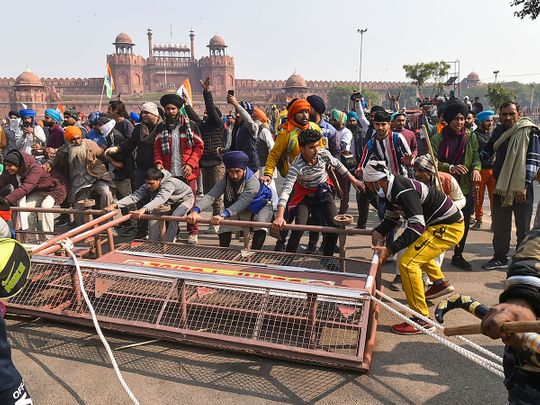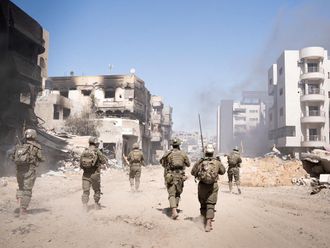
On India’s Republic Day, the violent clashes between protesting farmers and the police marked a major turning point in what had been, until now, a peaceful protest by farmers for nearly 60 days at the borders of the national capital.
The visuals of protesters entering the Red Fort, ploughing tractors through barricades and even trying to run over the police has pushed farmers on the back foot after a legitimate protest.
This perhaps plays right into the hands of the ruling BJP that wanted nothing more than to smear these protests as anti national.
Political mudslinging continues
As I write this, there is political mudslinging and much wrangling between the farmer unions and the police. The details of what went down are still not entirely clear but a broad picture has emerged- protesting farmer unions had signed an agreement with the Delhi police that they would do their tractor march on Republic Day only on three chosen routes at a particular time.
What went down at the Red Fort therefore cannot absolve farmer leaders of their responsibility. And one of their visible faces, Yogendra Yadav has expressed regrets about what happened and accepted moral responsibility.
Farmer unions who were protesting together until now are clearly divided on the next steps. Two unions have now withdrawn from the protests and a planned march to Parliament on Budget Day has been scrapped.
The role of Deep Sidhu, a Punjabi actor who campaigned for BJP MP Sunny Deol in the 2019 Lok Sabha elections, needs greater scrutiny. For weeks, leading farmer unions were distancing themselves from Sidhu and his radical views. Videos and media reports show him as a key player in the Red Fort fiasco.
Farm leaders believe he was planted to discredit their cause. Though Sidhu too has been named in the string of FIRs filed by the Delhi police. But will he face the full force of the law as has been declared will happen to others?
Debate on the flag
Much of the conversation about the events of January 26 also revolve around the Sikh flag that was raised at the Red Fort by some of the protesters and justified by Deep Sidhu. Contrary to social media propaganda by the right wing, no Khalistani flag was raised and the Indian tricolor was not brought down. But was this hoisting of the flag really necessary? Why was an attempt made to give the farmer protests a religious colour?
This is an issue that affects farmers across the board and making it only about one community undermines that cause. On the other hand one can argue that our political leadership has openly flaunted religious symbols in public, even at government events, so what is to stop citizens from doing the same?
As far as the police are concerned, they exercised far more restraint than they have in the past in dealing with protesters and mobs, despite serious provocation. But the police must answer as to why they were so clearly outnumbered and unprepared to deal with the situation, despite claiming in their own press conference that they had prior intelligence inputs that there may be trouble during the tractor march.
The police had said they first received information about the tractor rally on January 2nd. Since then they had around six rounds of talks with the farmers unions on routes, timings etc.
Throughout this process they say they received several intelligence inputs which were promptly acted upon. For example, the police approached Twitter to remove over 300 accounts that were instigating violence.
The police also admit to getting inputs on Jan 25 evening that farmers are planning to break the barricades and go against the agreed routes and timings.
So how did the police allow the situation in the national capital to reach this point of violence and vandalism?
Discrediting a movement
There is however bigger story emerging from this confrontation. It is the pattern of the BJP government seeking to vilify and delegitimise any protest in a democracy. What starts as a peaceful agitation ends up being discredited because a small element turned violent.
It happened during the anti CAA protests, Shaheen Bagh, Jamia, and more. Like these protests, the farmer agitation had been largely peaceful. Farmers braved the biting cold, battled the police in earlier confrontations and lost many of their own in the course of this movement against the farm laws.
The government, which rammed through the farm laws without any proper debate even in parliament, cannot claim a high moral ground.
In UP, the Allahabad High Court wants to know why protesting farmers in the Sitapur district have been asked to furnish bonds ranging from 50000 rupees to 10 lakh rupees “on the apprehension that they may violate law and order”. In every protest, the government and its supporters have sought to tarnish an entire community or group even if only a small number actually took to violence.
It is also ironic that the BJP blames the Congress for instigating protests. If the Congress had such a sway over people, they would be winning elections. Those speaking out against protests taking a violent turn today have forgotten the Nirbhaya protests in Delhi in 2012 which also resulted in violent clashes with police. Or the Mandal agitation of 1990.
What happens next will be interesting to see. Farmer unions are now divided on the path ahead and while the government has gone on the offensive, the BJP also knows that targeting farmers beyond a point could backfire politically. But most importantly- where does India stand as a democracy?










